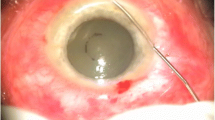Abstract
Purpose: The effectiveness of an intraocular injection of combined gentamicin and clindamycin in the prevention of acute posttraumatic bacterial endophthalmitis following penetrating ocular injuries was evaluated in a prospective, double-masked, randomized pilot study. Methods: Sixty eyes of 60 patients with penetrating ocular injuries were treated at a tertiary care hospital. Following primary repair, the eyes were randomized in two groups. Group 1, the antibiotic injection group (cases), was given an intracameral or intravitreal injection of 0.1 mL antibiotic (40 μg gentamicin and 45 μg clindamycin). Group 2 (balanced saline solution [BSS] injection group [controls]) received intracameral or intravitreal injection of 0.1 mL BSS. All patients received standard prophylactic antibiotic therapy (systemic, subconjunctival, and topical). Result: Although the overall incidence of acute posttraumatic bacterial endophthalmitis was 6.6% (4 eyes), the results of three cultures were negative. All endophthalmitis cases occurred in the BSS injection group; however, there was no statistically significant difference between case and control groups (p = 0.11). The incidence rate for those with retained intraocular foreign bodies was 13.3% and for those without foreign bodies was 4.4%. No retinal toxicity was detected. Conclusion: Intraocular injection of gentamicin and clindamycin in addition to the other methods of prophylaxis may be an effective modality in the prevention of posttraumatic endophthalmitis. Early results suggest that these antibiotics may have a role as adjunct therapy to primary repair of injured globes without significant side effects at the dosage used.
Similar content being viewed by others
References
Boldt HC, Pulido JS, Blodi CF, Folk JC, Weingeist TA. Rural endophthalmitis. Ophthalmol 1989; 96: 1722–1726.
Thompson WS, Rubsamen PE, Flynn HW Jr, Schiffman J, Cousins SW. Endophthalmitis after penetrating trauma: Risk factors and visual acuity outcomes. Ophthalmol 1995; 102: 1696–1701.
Alfaro DV, Runyan T, Kirkman E, Tran VT, Liggett PE. Intravenous cefazolin in penetrating eye injuries: Treatment of experimental posttraumatic endophthalmitis. Retina 1993; 13: 331–334.
Endophthalmitis Vitrectomy Study Group. Results of the Endophthalmitis Vitrectomy Study: A randomized trial of immediate vitrectomy and of intravenous antibiotics for the treatment of postoperative bacterial endophthalmitis. Arch Ophthalmol 1995; 113: 1479–1496.
Foster RE, Martinez JA, Murray TG, Rubsamen PE, Flynn HW, Forster RK. Useful visual outcomes after treatment of Bacillus cereus endophthalmitis. Ophthalmol 1996; 103: 390–397.
Mieler WF, Ellis MK, Williams DF, Han DP. Retained intraocular foreign bodies and endophthalmitis. Ophthalmol 1990; 97: 1532–1538.
Hogan MJ, Kimura SJ, Thygeson P. Signs and symptoms of uveitis I. Anterior uveitis. Am J Ophthalmol 1959; 47: 155–170.
Duch-Samper AM, Menezo JL, Hurtado-Sarrio M. Endophthalmitis following penetrating eye injuries. Acta Ophthalmol Scand 1997; 75: 104–106.
Peyman GA. Antibiotic administration in the treatment of bacterial endophthalmitis. II. Intravitreal injections. Surv Ophthalmol 1977; 21: 332, 339–346.
Bohigian GM, Olk RJ. Factors associated with a poor visual result in endophthalmitis. Am J Ophthalmol 1986; 101: 332–341.
Alfaro DV, Liggett PE. Intravenous cefazolin in penetrating eye injuries. I. Effects of trauma and multiple doses on intraocular delivery. Graefes Arch Clin Exp Ophthalmol 1994; 232: 236–241.
Joosse MV, Van Tilburg CJ, Mertens DA, Peperkamp E, Van Meurs JC, Ringens PJ, Jager GV, Beekhuis WH. Endophthalmitis: Incidence, therapy and visual outcome in the period 1983; 1992 in the Rotterdam Eye Hospital. Doc Ophthalmol 1992; 82: 115–123.
Barza M, Kane A, Baum J. Intraocular penetration of gentamicin after subconjunctival and retrobulbar injection. Am J Ophthalmol 1978; 85: 541–547.
Campochiaro PA, Conway BP. Aminoglycoside toxicity-a survey of retinal specialists: Implications for ocular use. Arch Ophthalmol 1991; 109: 946–950.
Campochiaro PA, Lim JL, the Aminoglycoside Toxicity Study Group. Aminoglycoside toxicity in the treatment of endophthalmitis. Arch Ophthalmol 1994; 112: 48–53.
Jonas JB, Knorr HLJ, Budde WM. Prognostic factors in ocular injuries caused by intraocular or retrobulbar foreign bodies. Ophthalmol 2000; 107: 823–828.
Author information
Authors and Affiliations
Rights and permissions
About this article
Cite this article
Soheilian, M., Rafati, N. & Peyman, G.A. Prophylaxis of acute posttraumatic bacterial endophthalmitis with or without combined intraocular antibiotics: a prospective, double-masked randomized pilot study. Int Ophthalmol 24, 323–330 (2001). https://doi.org/10.1023/B:INTE.0000006768.66170.c1
Issue Date:
DOI: https://doi.org/10.1023/B:INTE.0000006768.66170.c1




